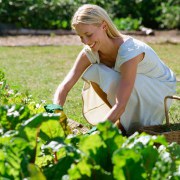 Photo: Getty Images
Photo: Getty Images
part II in a series
Getting Started, Staying Healthy
The snow had barely started to melt when Kathy Delaney, a resident of Minneapolis, began sorting her seeds for a spring garden. Some of the vegetables, like cabbage, Brussels spouts and tomatoes, will be sowed in peat pots now for planting outdoors later on. Other garden treasures— corn, arugula, eggplants, romaine lettuce, melons, and a splash of herbs— will be sown as seeds as soon as the weather permits.
Delaney is part of a growing global movement of backyard gardeners who grow most of their food. This is the fifth garden she has planted in the sunny, rich brown plot of soil in the center of her backyard where there was once lawn. Her three children, ages 4-9, help her keep the the rows groomed and watering and do the harvesting, what they refer to as the “yummy job.”
“It’s very much a family affair,” says Delaney. “It’s something we enjoy doing together, so we have a lot of fun in the garden. It is truly a source of pride to watch our food go from seedling to the table.”
Delaney’s garden feeds her family of five all summer and into the late fall. She prefers to enjoy the vegetables fresh rather than canning or freezing them, because “they just taste so much better that way,” she says.
“I feel so good knowing that we are cutting our food bill by more than half and still serving healthy food to my family. I am also giving skills to my children that will stick with them a lifetime.” In the future, Delaney plans to expand her garden to a four-season variety to ensure fresh, healthy food is always available.
Roger Doiron, founder of Kitchen Gardeners International, a global online community of people growing their own food and building relationships in the process, said the idea of the kitchen garden is turning the western concept of convenient and “fast food” on its head.
“A kitchen garden doesn’t have to be right outside the kitchen door, but the closer it is, the better. Think about it this way: The easier it is for you to get into the garden, the more likely it is that you will get tasty things out of it,” Doiron said. “And what could be more convenient and fast than having your pick of over 40 nutritious foods straight from your own garden?”
Homegrown vegetables are healthier than store bought Doiron says because the commercially grown foods we’re eating today are significantly less nutritious than just 30 years ago. “Breeding crops for higher yields has delivered cheaper food, but it has also diluted nutrients,” he said. Furthermore, most kitchen gardeners don’t expose their vegetables to toxins, so it is safer, fresher and tastes better.
Doiron said anyone can grow their own food regardless of where they live. If space seems like an issue, think about container gardens, rooftop gardens or create a window or planter box garden.
“I’m convinced when people look around they will discover they have enough resources to get started,” Doiron said. He recommends new gardeners start small, tuck a few successes under their belt in year one, and scale up little by little.
“Even in year one, you may be able to meet a big chunk of your family’s produce needs, he said “Kitchen gardens and gardeners thrive because of positive feedback loops. If your garden harvests taste good and make you feel good, you will feel more motivated to keep on growing.”
Thinking something larger but simply don’t have the space? Community gardens and yard sharing gardens are gaining popularity. Community gardens are spring up across the U.S. and Canada and new ones are starting all the time.
According to the American Community Garden Association, bare weedy lots in inner cities, suburban and rural areas alike are becoming green community gardens where neighbors come together to beautify their street, improve their quality of life, reduce crime, and provide nutritious food for the community.
Some community gardens, such as the one grown by Little Red Door Cancer Agency in Marion County, Indiana teamed with the American Cancer Society, The Indiana Cancer Consortium and the Indiana Dietetic Association to grow a variety of cancer-fighting foods high in antioxidants and nutrients on two 15-foot plots to benefit the entire community.
“Starting a community garden is a learning process, but the outcomes far outweigh the risks. This garden has really helped highlight the importance of disease prevention in our community,” says Tanya Parrish, Little Red Door.
To see if there is a community garden near you, or to learn how to start one, visit http://www.communitygarden.org. You can connect to local kitchen gardeners through Kitchen Garden International. The website also offers resources and inspiration to get you started and keep you active.
Lynette Summerill is an award-winning writer who lives in Scottsdale, Arizona. In addition to writing about cancer-related issues for EmpowHER, her work has been seen in newspapers and magazines around the world.






Add a CommentComments
There are no comments yet. Be the first one and get the conversation started!